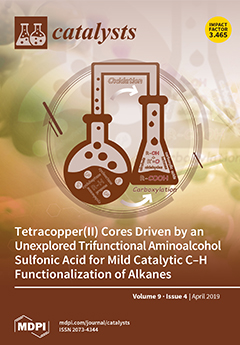A series of Sc-doped ZrO
2 supports, with Sc
2O
3 content in the range of 0 to 7.5% (mol/mol), were prepared using the hydrothermal method. Ni/Sc-doped ZrO
2 catalysts with nickel loading of 10% (
w/
w) were prepared using impregnation method, and characterized with the use of XRD, Raman, H
2 temperature-programmed reduction (H
2-TPR), H
2 temperature-programmed desorption (H
2-TPD), XPS, and in situ FT-IR techniques. The catalytic performances of Ni/Sc-doped ZrO
2 catalysts in maleic anhydride hydrogenation were tested. The results showed that the introduction of Sc
3+ into ZrO
2 support could effectively manipulate the distribution of maleic anhydride hydrogenation products. γ-butyrolactone was the major hydrogenation product over Sc-free Ni/ZrO
2 catalyst with selectivity as high as 65.8% at 210 °C and 5 MPa of H
2 pressure. The Ni/Sc-doped ZrO
2 catalyst, with 7.5 mol% of Sc
2O
3 content, selectively catalyzed maleic anhydride hydrogenation to succinic anhydride, the selectivity towards succinic anhydride was up to 97.6% under the same reaction condition. The results of the catalysts’ structure–activity relationships revealed that there was an interdependence between the surface structure of ZrO
2-based support and the C=O hydrogenation performance of the ZrO
2-based supported nickel catalysts. By controlling the Sc
2O
3 content, the surface structure of ZrO
2-based support could be regulated effectively. The different surface structure of ZrO
2-based supports, resulted in the different degree of interaction between the nickel species and ZrO
2-based supports; furthermore, the different interaction led to the different surface oxygen vacancies electron properties of ZrO
2-based supported nickel catalysts and the C=O hydrogenation activity of the catalyst. This result provides new insight into the effect of ZrO
2 support on the selective hydrogenation activity of ZrO
2-supported metal catalysts and contributes to the design of selective hydrogenation catalysts for other unsaturated carbonyl compounds.
Full article





